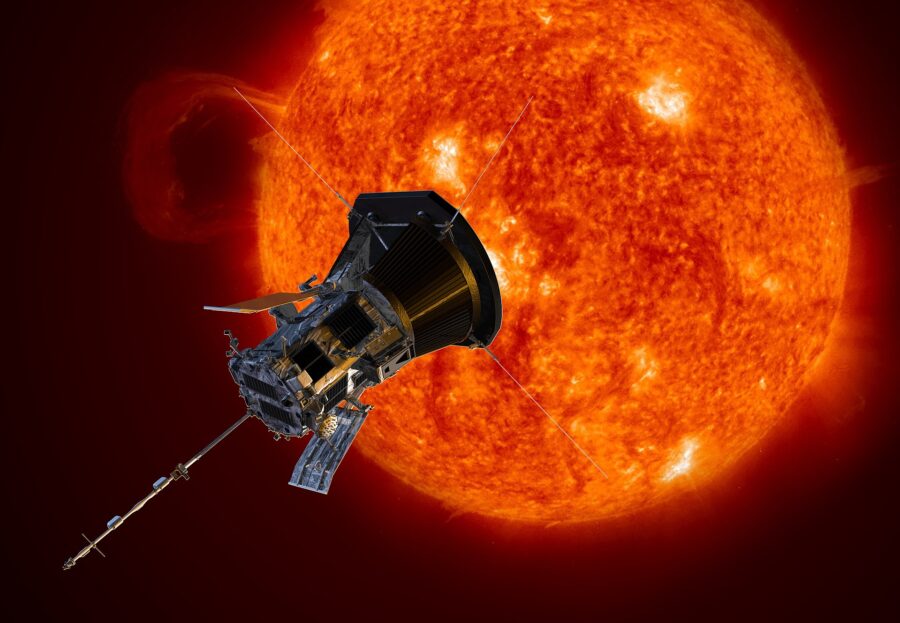The Fastest Object Ever Built By Man Just Touched The Sun
This article is more than 2 years old

NASA has just set another record. In fact, NASA set two records, then went on to shatter both by claiming two more.
If you have not heard of NASA’s Parker Solar Probe, well now you have. The probe, which was launched in 2018 to study the sun, is small, roughly the size of a small car. But the teeny spacecraft is also scorch-proof, which allows it to get as close as ever to Earth’s heater. Parkers have been using Venus as its slingshot to fly (or shall we say zip) along the outer regions of the Sun.
But what about these records? Back in February 2020, Parker set two unbelievable records. The first was the fastest ever human-made object when it clocked in at 244,255 miles per hour. Yes, you read that correctly. NASA made a ship that could travel that fast through space. At that time, Parker was also 11.6 million miles from the Sun, the closest spacecraft ever to reach the burning ball.

Now, though, Parker has not only broken their own 2020 space records, but it has also shattered them. In late April of this year, Parker found itself the closest to the Sun ever at 6.5 million miles. To those in the know, this is called “perihelion”, a word typically used to describe when a planet, an asteroid, or a comet is closest to the sun. This time, however, it was the Parker Solar Probe.
If cutting its distance virtually in half in terms of closeness to the Sun wasn’t enough, Parker also set a speed record… by a lot. As it reached the closest point to the Sun, Parker was clocked in at 330,000 miles per hour. Almost one hundred thousand miles per hour faster than its first record. At 330,000, Parker could circle the Earth 13 times in ONE HOUR. Talk about nauseating.
Amazing. Simply amazing. It’s hard to comprehend the speed with which Parker is traveling and according to NASA, these two new records are child’s play. Later in the year, around the November time frame, Parker will use Venus once again to slingshot even close to the Sun as Perihelion is expected around November 21, 2021. Parker should eclipse both the nearness to the Sun and speed records during that time.

The Parker Solar Probe has already made eight successful flyby’s. Its mission is to explore or “touch” the Sun. The goal is to get as close to the star as possible, sending home important data of the Sun’s atmosphere. Four papers were published in the journal Nature, explaining in scientific detail the data being sent home to NASA.
One of the more interesting figures coming from the papers were the temperatures noted from inside the Sun’s aura of plasma, which is a region called the corona. Scientists have been able to analyze the temperatures within the corona based on Parker’s first two close approaches, which came in November 2018 and April 2019. The temperatures range anywhere from 2 million and 5 million degrees Fahrenheit. Talk about instant sunburn.
The inside of the corona also generates a solar wind, which are streams of energetic particles that blast out into our solar system. Until recently, astronomers have had to measure these solar wind streams as they get closer to Earth, but with Parker’s impressive heat shield and state-of-the-art tools, they can now take a closer look at the secrets our Sun has been keeping from us.
Impressive heat shield aside, and it has to be to get so close to the Sun, Parker also employs a wide-field imager to send amazing photos back to NASA and three separate devices capable of measuring the varied particles in the Sun’s solar wind. They also have the ability to measure the magnetic and electric fields which surround the Sun.
Another finding that scientists have found fascinating is that the solar wind, as measured, is not behaving as how they predicted. Before Parker, scientists could only measure the solar wind particles as they shot in straight trajectories out from the Sun across Earth. But Parker has shown researchers that there is a surprising increase in “rotational flow” that wasn’t seen previously.
“The large rotational flow of the solar wind seen during the first encounters has been a real surprise,” said Justin Kasper, lead researcher in a press release. “While we hoped to eventually see rotational motion closer to the Sun, the high speeds we are seeing in these first encounters is nearly ten times larger than predicted by the standard models.”
Besides breaking more records, what is next for the Parker Solar Probe? Well, the tiny but fast spacecraft will continue to explore the Sun until 2025. The goal is to get close than ever and continue to explore the Sun’s corona as well as its surface. Parker also hopes to help scientists understand just how the solar wind blasted into our solar system affects the solar system.











